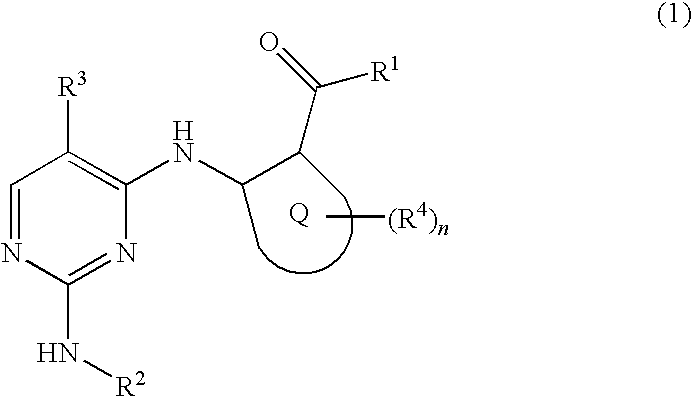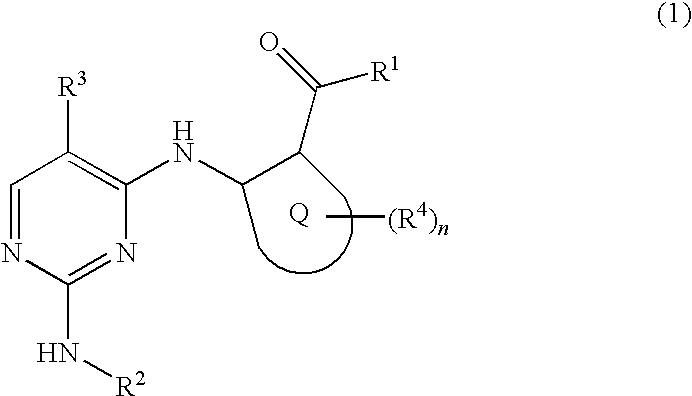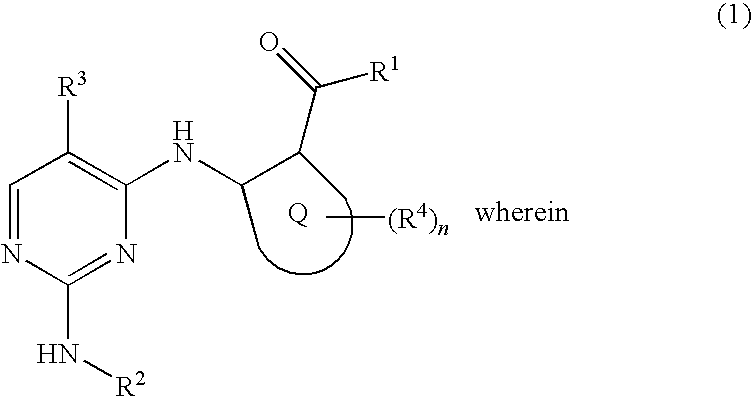2, 4-diaminopyrimidide derivates and their use for the treatment of cancer
a technology of diaminopyrimidide and derivates, which is applied in the direction of drug compositions, antibacterial agents, immunological disorders, etc., can solve problems such as uncontrolled growth
- Summary
- Abstract
- Description
- Claims
- Application Information
AI Technical Summary
Benefits of technology
Problems solved by technology
Method used
Image
Examples
example 1
2-[2-methoxy-4-(2-pyrrolidin-1-yl-ethylcarbamoyl)-phenylamino]-4-(2-ethyl-1-oxo-1,2,3,4-tetrahydro-pyrrolo[1,2-a]pyrazin-8-ylamino)-5-trifluoromethyl-pyrimidine
[0120]
[0121]33 mg (0.09 mmol) of 2-(4-carboxyamino-2-methoxy-phenylamino)-4-chloro-5-trifluoromethyl-pyrimidine (Method 1) are dissolved in 100 μL N-methyl-2-pyrrolidinone and combined with 61 mg (0.14 mmol; content approx. 40%) 8-amino-2-ethyl-3,4-dihydro-2H-pyrrolo[1,2-a]pyrazin-1-one (Method 2). 15 μL of a 4 M solution of HCl (0.06 mmol) in 1,4-dioxane are metered into this reaction mixture. After 1 h at 100° C. the reaction mixture is stirred into 50 mL of an aqueous 1 N hydrochloric acid. The precipitate is filtered off and dried in vacuo. 34 mg (0.07 mmol) of this precipitate, 50 μL (0.31 mmol) N-ethyldiisopropylamine, 27 mg (0.08 mmol) O-(benzotriazol-1-yl)-N,N,N′,N′-tetramethyluronium-tetrafluoroborate and 13 μL (0.1 mmol) 1-(2-aminoethyl)-pyrrolidine are dissolved in 4 mL dichloromethane. After 1.5 h at ambient tempe...
examples 2-21
[0125]The following compounds are prepared by an analogous method to that described in Example 1.
[0126]The preparation of 2-(4-carboxyamino-phenylamino)-4-chloro-5-trifluoromethyl-pyrimidine is described in Method 1. The corresponding aniline is described in Method 2 or may be obtained commercially. The amine used to prepare the amide is commercially obtainable or is described in one of methods 3-5.
UV maxMS (ESI)#AR[nm](M + H)+2286, 3155503285, 3255504320, 2865915286, 3145766317559732065783206839320615103156011132262912320573133206291432065515320643163216691732058718322615193226012058821604
example 22
2-(2-methoxy-4-piperazin-1-yl-phenylamino)-4-(2-ethyl-1-oxo-1,2,3,4-tetrahydro-pyrrolo 1,2-a]pyrazin-8-ylamino)-5-trifluoromethyl-pyrimidine
[0127]
[0128]126 mg (0.21 mmol) 2-[4-(4-benzyloxycarbonyl-piperazin-1-yl)-phenylamino]-4-chloro-5-trifluoromethyl-pyrimidine are dissolved in 0.1 ml N-methyl-2-pyrrolidinone, then combined with 50 mg (0.21 mmol) 8-amino-2-ethyl-3,4-dihydro-2H-pyrrolo[1,2-a]pyrazin-1-one (Method 2) and with 25 μL (0.1 mmol) dioxanic hydrochloric acid. This reaction mixture is stirred for 1.5 h at 100° C. After 1 h at 100° C. the reaction mixture is stirred into 50 mL of an aqueous 1 N hydrochloric acid. The precipitate is filtered off and dried in vacuo. 113 mg (0.17 mmol) of the above-mentioned intermediate product are dissolved in 40 mL DMF and mixed with an amount of distilled water such that precipitation is only just avoided. 30 mg palladium on charcoal are added to this solution and it is hydrogenated at 7 bar hydrogen pressure and 20° C. for 3 h. The cataly...
PUM
| Property | Measurement | Unit |
|---|---|---|
| temperature | aaaaa | aaaaa |
| temperature | aaaaa | aaaaa |
| temperature | aaaaa | aaaaa |
Abstract
Description
Claims
Application Information
 Login to View More
Login to View More - R&D
- Intellectual Property
- Life Sciences
- Materials
- Tech Scout
- Unparalleled Data Quality
- Higher Quality Content
- 60% Fewer Hallucinations
Browse by: Latest US Patents, China's latest patents, Technical Efficacy Thesaurus, Application Domain, Technology Topic, Popular Technical Reports.
© 2025 PatSnap. All rights reserved.Legal|Privacy policy|Modern Slavery Act Transparency Statement|Sitemap|About US| Contact US: help@patsnap.com



